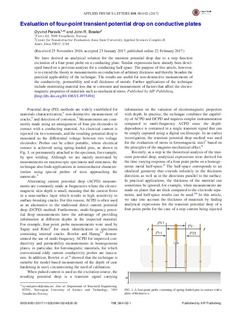Evaluation of four-point transient potential drop on conductive plates
Journal article, Peer reviewed
Published version
Permanent lenke
http://hdl.handle.net/11250/2587131Utgivelsesdato
2017Metadata
Vis full innførselSamlinger
Sammendrag
We have derived an analytical solution for the transient potential drop due to a step function excitation of a four-point probe on a conducting plate. Similar expressions have already been developed based on a previous analysis for a conducting half-space. The purpose of this article, however, is to extend the theory to measurements on conductors of arbitrary thickness and thereby broaden the practical applicability of the technique. The results are useful for non-destructive measurements of the conductivity, permeability and wall thickness of metals. Further applications of the technique include monitoring material loss due to corrosion and measurement of factors that affect the electromagnetic properties of materials such as mechanical stress.
Potential drop (PD) methods are widely established for materials characterization,1 non-destructive measurement of cracks,2 and detection of corrosion.3 Measurements are commonly made using an arrangement of four pin electrodes in contact with a conducting material. An electrical current is injected via two terminals, and the resulting potential drop is measured as the differential voltage between two voltage electrodes. Probes can be either portable, where electrical contact is achieved using spring-loaded pins, as shown in Fig. 1, or permanently attached to the specimen, for example, by spot welding. Although we are mainly motivated by measurements on macroscopic specimens and structures, the technique also finds applications in semiconductor characterization using special probes of sizes approaching the nanoscale.4
